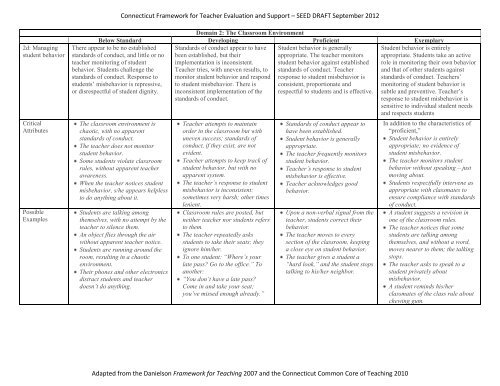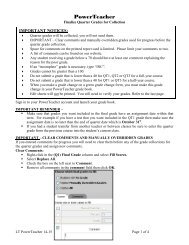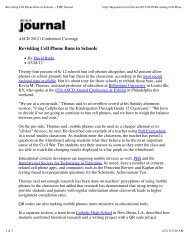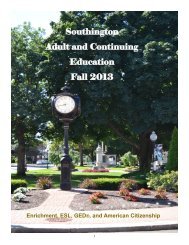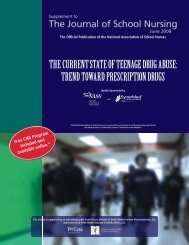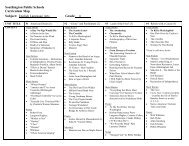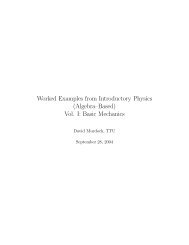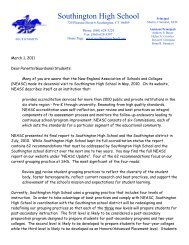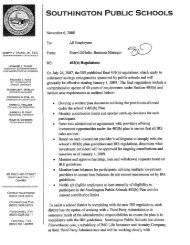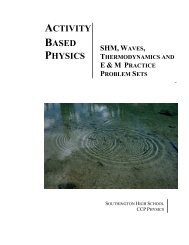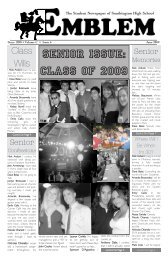Connecticut Framework for Teacher Evaluation and Support â SEED ...
Connecticut Framework for Teacher Evaluation and Support â SEED ...
Connecticut Framework for Teacher Evaluation and Support â SEED ...
Create successful ePaper yourself
Turn your PDF publications into a flip-book with our unique Google optimized e-Paper software.
<strong>Connecticut</strong> <strong>Framework</strong> <strong>for</strong> <strong>Teacher</strong> <strong>Evaluation</strong> <strong>and</strong> <strong>Support</strong> – <strong>SEED</strong> DRAFT September 2012<br />
2d: Managing<br />
student behavior<br />
Critical<br />
Attributes<br />
Possible<br />
Examples<br />
Domain 2: The Classroom Environment<br />
Below St<strong>and</strong>ard Developing Proficient Exemplary<br />
St<strong>and</strong>ards of conduct appear to have Student behavior is generally<br />
been established, but their<br />
appropriate. The teacher monitors<br />
implementation is inconsistent. student behavior against established<br />
<strong>Teacher</strong> tries, with uneven results, to st<strong>and</strong>ards of conduct. <strong>Teacher</strong><br />
monitor student behavior <strong>and</strong> respond response to student misbehavior is<br />
to student misbehavior. There is consistent, proportionate <strong>and</strong><br />
inconsistent implementation of the respectful to students <strong>and</strong> is effective.<br />
st<strong>and</strong>ards of conduct.<br />
There appear to be no established<br />
st<strong>and</strong>ards of conduct, <strong>and</strong> little or no<br />
teacher monitoring of student<br />
behavior. Students challenge the<br />
st<strong>and</strong>ards of conduct. Response to<br />
students’ misbehavior is repressive,<br />
or disrespectful of student dignity.<br />
The classroom environment is<br />
chaotic, with no apparent<br />
st<strong>and</strong>ards of conduct.<br />
The teacher does not monitor<br />
student behavior.<br />
Some students violate classroom<br />
rules, without apparent teacher<br />
awareness.<br />
When the teacher notices student<br />
misbehavior, s/he appears helpless<br />
to do anything about it.<br />
Students are talking among<br />
themselves, with no attempt by the<br />
teacher to silence them.<br />
An object flies through the air<br />
without apparent teacher notice.<br />
Students are running around the<br />
room, resulting in a chaotic<br />
environment.<br />
Their phones <strong>and</strong> other electronics<br />
distract students <strong>and</strong> teacher<br />
doesn’t do anything.<br />
<strong>Teacher</strong> attempts to maintain<br />
order in the classroom but with<br />
uneven success; st<strong>and</strong>ards of<br />
conduct, if they exist, are not<br />
evident.<br />
<strong>Teacher</strong> attempts to keep track of<br />
student behavior, but with no<br />
apparent system.<br />
The teacher’s response to student<br />
misbehavior is inconsistent:<br />
sometimes very harsh; other times<br />
lenient.<br />
Classroom rules are posted, but<br />
neither teacher nor students refers<br />
to them.<br />
The teacher repeatedly asks<br />
students to take their seats; they<br />
ignore him/her.<br />
To one student: “Where’s your<br />
late pass Go to the office.” To<br />
another:<br />
“You don’t have a late pass<br />
Come in <strong>and</strong> take your seat;<br />
you’ve missed enough already.”<br />
St<strong>and</strong>ards of conduct appear to<br />
have been established.<br />
Student behavior is generally<br />
appropriate.<br />
The teacher frequently monitors<br />
student behavior.<br />
<strong>Teacher</strong>’s response to student<br />
misbehavior is effective.<br />
<strong>Teacher</strong> acknowledges good<br />
behavior.<br />
Upon a non-verbal signal from the<br />
teacher, students correct their<br />
behavior.<br />
The teacher moves to every<br />
section of the classroom, keeping<br />
a close eye on student behavior.<br />
The teacher gives a student a<br />
“hard look,” <strong>and</strong> the student stops<br />
talking to his/her neighbor.<br />
Student behavior is entirely<br />
appropriate. Students take an active<br />
role in monitoring their own behavior<br />
<strong>and</strong> that of other students against<br />
st<strong>and</strong>ards of conduct. <strong>Teacher</strong>s’<br />
monitoring of student behavior is<br />
subtle <strong>and</strong> preventive. <strong>Teacher</strong>’s<br />
response to student misbehavior is<br />
sensitive to individual student needs<br />
<strong>and</strong> respects students<br />
In addition to the characteristics of<br />
“proficient,”<br />
Student behavior is entirely<br />
appropriate; no evidence of<br />
student misbehavior.<br />
The teacher monitors student<br />
behavior without speaking – just<br />
moving about.<br />
Students respectfully intervene as<br />
appropriate with classmates to<br />
ensure compliance with st<strong>and</strong>ards<br />
of conduct.<br />
A student suggests a revision in<br />
one of the classroom rules.<br />
The teacher notices that some<br />
students are talking among<br />
themselves, <strong>and</strong> without a word,<br />
moves nearer to them; the talking<br />
stops.<br />
The teacher asks to speak to a<br />
student privately about<br />
misbehavior.<br />
A student reminds his/her<br />
classmates of the class rule about<br />
chewing gum.<br />
Adapted from the Danielson <strong>Framework</strong> <strong>for</strong> Teaching 2007 <strong>and</strong> the <strong>Connecticut</strong> Common Core of Teaching 2010


